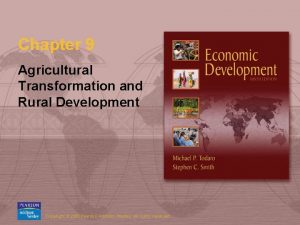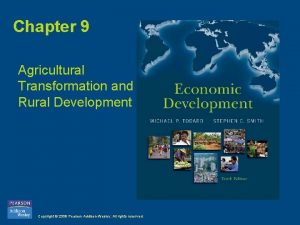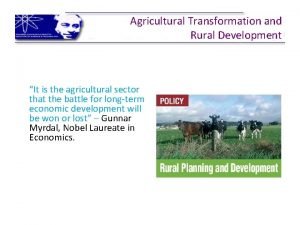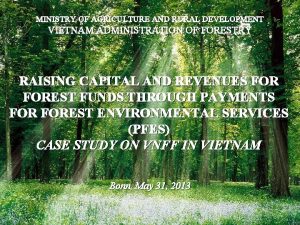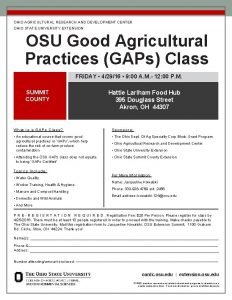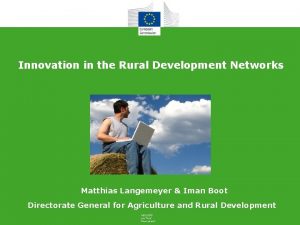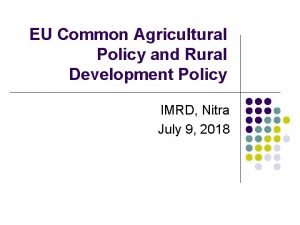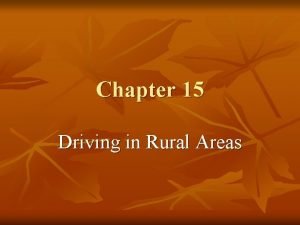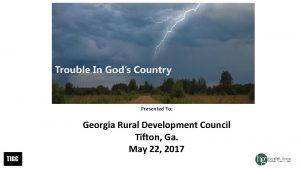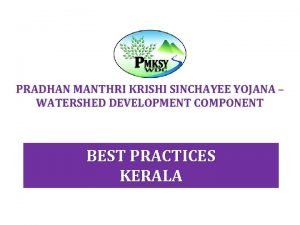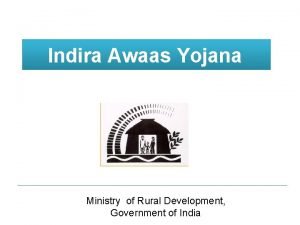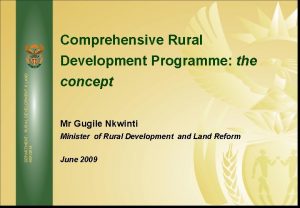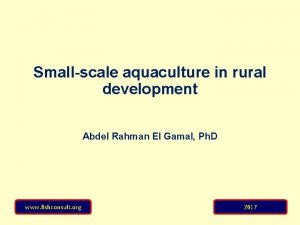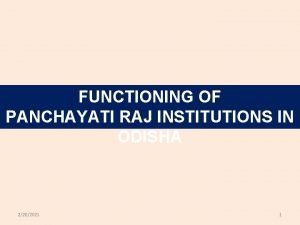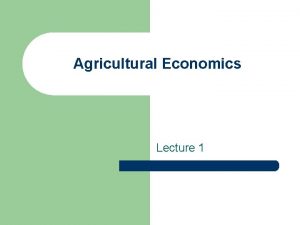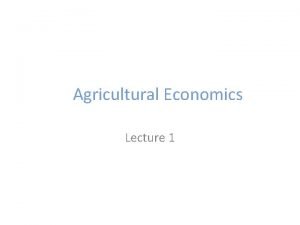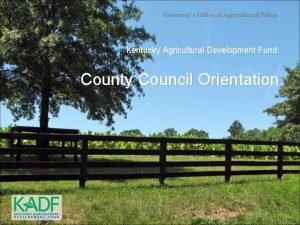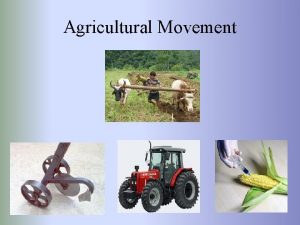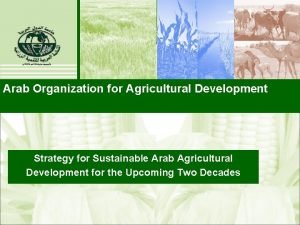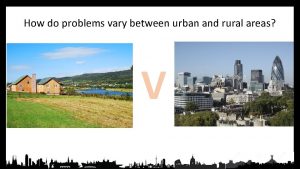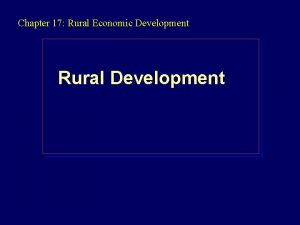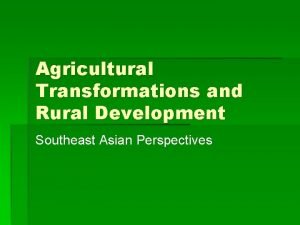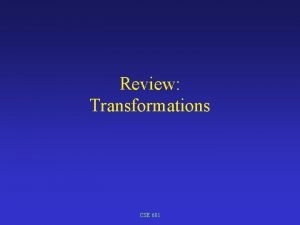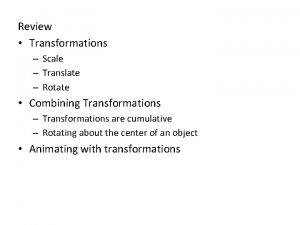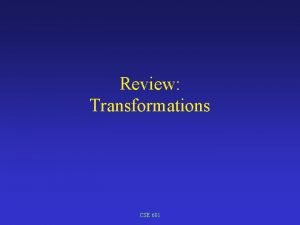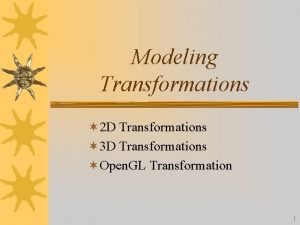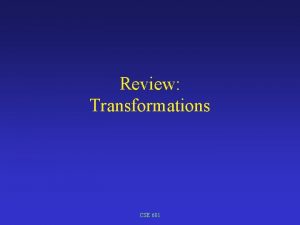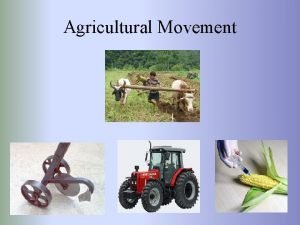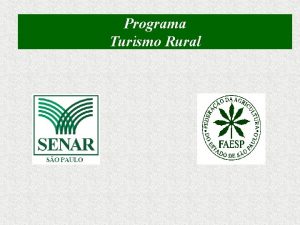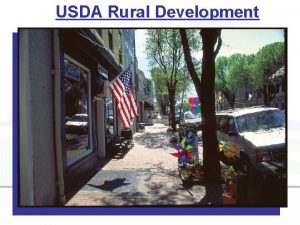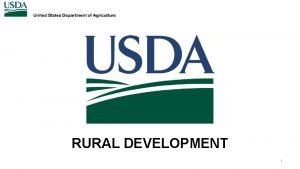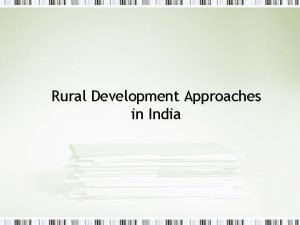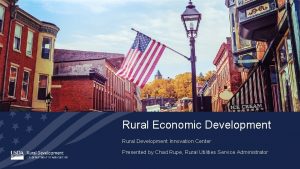Agricultural Transformations and Rural Development Agricultural Systems Useful

























- Slides: 25

Agricultural Transformations and Rural Development

Agricultural Systems § Useful to view agriculture in a systems framework: inputs, outputs and linkages § Inputs- labor, fertilizer, seeds, land preparation, land quality and tenure § Outputs- production in form of mature crops and income earned and allocated § Linkages- labor intensity > type of crop (rice, rubber, etc); land size>income earned and traditional system § But inputs, outputs are linked through three overlapping milieu or environments

§ A- Physical - Ecosystemespecially climate Agricultural Systems (precipitation), soil and vegetation § B- Behavioral - how ecosystem is perceived. A-Physical Environment physical and behavioral may be in conflict § C- Operational - culture, values, class structures, institutions and tradition, political system, technology level-farm management, land tenure B-Behavioral C-Operational -all influence and govern Milieu Environment machinery of production, consumption and exchange

Agrarian Structure § Agrarian structure refers to ways in which agricultural system is developed on the land includes land ownership, cropping system, and institutions § Land tenure- who owns or controls the land § Communal tenure- land held by village where villagers enjoy usufruct (right to use and profit) § Latifundia –large estates where wage laborers are employed by private sector firms (agribusiness), or plantations held by public sector § Freehold- outright ownership with land being transferred and divided equally among (usually males) § Tenancy- farmers pay owners for use of land either in cash or kind (production)

Forms of Agriculture http: //www. askasia. org/frclasrm/lessplan/l 000008. htm § Wet rice (sawah or padi) cultivation- rice grown in an embanked field relying on natural rainfall or irrigation. Highly labor intensive and naturally fertile. Irrigation adds fertility through deposition of material in suspension. Capable of involution and highly impacted by the Green Revolution- hybrid seeds, fertilizers and pesticides used to enhance productivity but assumes abundant water

Green Revolution § Green Revolution - production revolution in grains associated with discovery of new hybrid seed varieties of wheat, rice, and corn § Resulted in high farm yields and allow double and triple cropping due to rapid maturity § But such seeds are dependent upon expensive inputs such as fertilizers, pesticides and above all require adequate water. § Produces higher incomes and may allow family members to divert to other non-farm occupations

Plantation or Estate Agriculture § Plantation or Estate Agriculture- foreign capital or public sector capital; large scale with rubber, oil palm, coffee and sugar cane being dominant; high labor requirements -labor supply problems; stimulated by Western now Eastern demand as well; significant capital investmentplanting, processing, re-planting

Rubber Plantations § Originally collected from wild trees in South America, now 90% of rubber production comes from plantations of rubber trees in Southeast Asia. § Thailand (southern) is largest producer where small holdings are dominant; Malaysia, Indonesia and Nigeria § Strong prices for latex have produced a boom § Huge demand from China—rubber tires and other products as well as global demand for rubber gloves (HIV)

Oil Palm Plantations § Oil palm originally from West Africa has overtaken rubber in many nations § Malaysia currently accounts for 51 % of world palm oil production and 62% of world exports § Other producers are Indonesia, Nigeria, Ivory Coast and Colombia § Numerous food and nonfood applications: frying media; margarines, shortenings, soap, oleochemicals and other products § Nutritional and health

Sedentary Farming § Sedentary dry farming- mostly smallholders growing cereal grains usually millets and sorghums § Sahel countries- Burkina Faso Chad, Mali, Niger, Sudan- desertification and aridity § Occasionally grown under irrigation where population density is generally low

Shifting Agriculture § Shifting cultivation- sometimes referred to as ‘swidden’ and means occupancy of the land interrupted by lengthy rest periods, clearing field and burning vegetation, sowing food crops; supports only a small population; extensive type of agriculture; diversity of crops planted to insure against natural hazard § Shifting cultivation usually starts with cutting trees and a fire which clears a spot for crop production (L) § In the ideal case, shifting cultivation is a cycle where farmers come back to the original place after a couple of years. The picture shows a newly prepared land in the center. In the background is untouched forest, in the foreground the piece of land which has been left idle to regrowth of a secondary forest from the previous cropping cycle, and on the right the secondary growth awaiting cultivation during the next cropping cycle. (R)

Fires, Slash and Burn and Indonesia § Slash/burn practiced in Borneo by Dayaks w/o creating ecological crisis § Burning has become excessive § Clearing old rubber plantations is major cause of fires—illegal but cheap § But local people also clear by fire as they farm larger areas § In dry years fire and smoke damage have huge consequences for property and health and the ecology of the forest

Highland Market Gardens § High elevation areas allow crops: carrots, tomatoes, cabbage, flowers § Labor intensive vegetable or tea production for urban markets § Well organized and export orientation § Examples: Cameron Highlands, Malaysia; Berastagi, Sumatra; Baguio, Philippines; Kandy, Sri Lanka

Constraints on Rural Developing World Agriculture § Small size of farms limit productivity of labor § Reduction in size of land parcels under inheritance tends to increase tenancy § Weak local or regional markets § Expensive inputs unless subsidized by government § Farm to market transport often poor and may be seasonal- collapsing in the wet season


Contrasting Peasant Agriculture in Latin America, Asia, and Africa § Common characteristic is the position of the family farm in all three areas § Latin America and Asia have very different heritages and cultures but peasant life is similar § Rural cultivator whose prime aim is survival § Farming techniques are scaled to his level of capital: human and animal power rather than mechanization § Food crops are dominant: corn, rice and soybeans

Contrasting Peasant Agriculture: Latin America § But nature of agrarian existence differed dramatically § Latin America- pattern of dualism known as latifundio (large land holdings > 15 persons) and minifundio (smallest farms <2 persons) § Problem: small number of latifundios control a large proportion of agriculture while vast number of minifundios scratch out existence § Problem: latifundios relatively inefficient because high proportion of land may be left idle § Problem: little reinvestment of profits to improve productivity

Contrasting Peasant Agriculture: Latin America § Land owners often value their holdings not for their contribution to national agricultural output but for power and prestige § Many small farmers exist on benevolence and goodwill of landowner-permits them a meager living § In return small farmers give up to 80 % of production of output § Tenant farmers may have to provide both output and free labor to the patron § Improved agricultural productivity in LA means more than seeds, fertilizers, higher output prices, and improved marketing § It means a reorganization of social and institutional structures for peasants to lift themselves up

Contrasting Peasant Agriculture: Asia § In LA- too much land under control of too few people § In Asia- too many people crowded onto too little land § Three forces have molded the traditional pattern of land ownership into its present condition § 1. European rule-private property, rise of landlord and creation of individual land titles § 2. Rise in power of the moneylender- with land titles land became a negotiable asset § 3. Rapid growth of Asian populations- impact has been severe fragmentation; as holdings shrink production falls below poverty level; peasants forced to borrow at usurious rates; large debts; forced to pay high rents with scarce land; labor abundant so wages are low; Myrdal’s vicious circles of poverty!!

Contrasting Peasant Agriculture: Africa § As in LA and Asia, subsistence on small plots is typical, but organization is very different § African agricultural systems dominated by three characteristics: § 1. Importance of subsistence farming in the village community § 2. Existence of land in excess of immediate needs (allows shifting cultivation) § 3. Rights of each family to have access to land water in immediate area (if you do not belong to community you are excluded)

Contrasting Peasant Agriculture: Africa § Low productivity subsistence is characteristic of most traditional African agriculture—Why? § 1. Traditional tools and limited technology restrict area that can be planted- although land is available (Animal power restricted) § 2. Small areas intensively cultivated- subject to diminishing returns and increased labor inputsshifting cultivation appropriate? § 3. Scarcity of labor during the growing seasonplanting and weeding. Only one rainy period over much of Africa, demand for workers at this time exceeds supply § Net result is virtually constant level of agricultural output and labor productivity throughout Africa

Off-Farm Employment § Off-farm employment (OFE) is a critical yet imperfectly understood phenomenon § Micro-level issues which address the nature of the employment, its prevalence and income impact must be further understood § OFE is central in many household survival strategies and a substantial proportion of income may be derived from off-farm work

The Location of Off Farm Employment § Many families meet subsistence needs by producing crops on farm and working at off farm jobs § The latter is often much more lucrative § Off farm employment applies to two different situations: § 1. Local -e. g. working on a neighbor’s land or operating a small shop § 2. Regional- e. g. coffee harvesting in another region, factory work and tradervendor in nearby town

Activity Forms in the Peasant Economy § Productive activities of rural peasants production for direct use in household (food processing, husking of grain, etc), non-farm income earning on farm (handicraft production), work on household farm (land prep, weeding, harvesting) and off-farm wage labor both farm (harvesting coffee) and non-farm (trishaw driver or factory worker). § Reproductive activities of rural peasants - daily maintenance of the household: cooking, sweeping, collecting firewood and water (Senegal), mending and washing clothes. These may be differentiated by biological (childbearing), generational (socialization and education of children), and daily (cooking, collecting water). §.

Peasants and Commodity Production § Commodification or Commoditization the increasing production of goods and services for the market (e. g. peanuts in Senegal). § Petty commodity production - form of production in capitalism that combines capital and labor within small, typically ‘household’ or ‘family’ enterprises
 Chapter 9 agricultural transformation and rural development
Chapter 9 agricultural transformation and rural development Chapter 9 agricultural transformation and rural development
Chapter 9 agricultural transformation and rural development Agricultural transformation and rural development
Agricultural transformation and rural development Ministry of agriculture and rural development cameroon
Ministry of agriculture and rural development cameroon Ecotourim
Ecotourim Ohio agricultural research and development center
Ohio agricultural research and development center Rural development
Rural development Rural development
Rural development Rural areas have of development drivers ed
Rural areas have of development drivers ed Usda rural development tifton ga
Usda rural development tifton ga Pradhan mantri krishi sinchayee yojana in kerala
Pradhan mantri krishi sinchayee yojana in kerala Ministry of rural development
Ministry of rural development Comprehensive rural development programme
Comprehensive rural development programme Kaavil farmfresh spices
Kaavil farmfresh spices Pesa act 1996
Pesa act 1996 Rural development loan massachusetts
Rural development loan massachusetts What is agricultural development
What is agricultural development What is agricultural development
What is agricultural development Kentucky office of agricultural policy
Kentucky office of agricultural policy Different stages of agriculture
Different stages of agriculture Arab organization for agricultural development
Arab organization for agricultural development Oplp medical
Oplp medical Decision support systems and intelligent systems
Decision support systems and intelligent systems Useful and harmful materials and their uses
Useful and harmful materials and their uses Urban rural difference
Urban rural difference Urban and rural meaning
Urban and rural meaning
